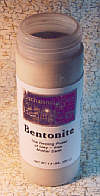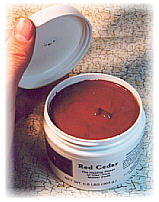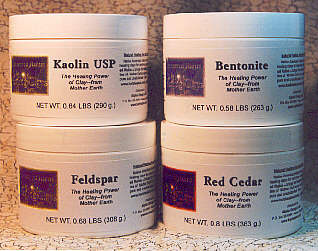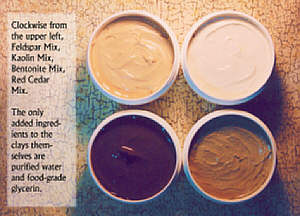
 he use of healing clay to treat a wide
variety of dermatological and digestive disorders
has been well-known to indigenous peoples around
the world. he use of healing clay to treat a wide
variety of dermatological and digestive disorders
has been well-known to indigenous peoples around
the world.
 South American tribes are known to
carry small balls of clay in their "travel sacks,"
which they reconstitute and mix with their food
to prevent food poisoning. The medicine men
of several American Plains Indians have been known to
instruct sufferers of various skin ailments to
apply clay mud from specific river banks --
producing results that often baffled modern
medical doctors.
South American tribes are known to
carry small balls of clay in their "travel sacks,"
which they reconstitute and mix with their food
to prevent food poisoning. The medicine men
of several American Plains Indians have been known to
instruct sufferers of various skin ailments to
apply clay mud from specific river banks --
producing results that often baffled modern
medical doctors.
 A more extensive
treatment on the background and use of healing clays
is given in Ran Knishinsky's book, "The Clay Cure."
(Read our nine-page
summary --
(DOC format, 597k); or
purchase
from Amazon). A more extensive
treatment on the background and use of healing clays
is given in Ran Knishinsky's book, "The Clay Cure."
(Read our nine-page
summary --
(DOC format, 597k); or
purchase
from Amazon).
Description of
Enchanted Ruins Healing Clays
 ur line of healing clays is divided into
two broad groups: Mix (which is temporarily
offline while the formulas are reworked) and
the more economical Pre-Mix products.
So there are four separate clay types. The only
ingredient in the "Pre-Mix" is the raw, powdered,
unreconstituted clay; whereas, the "Mix" products are the pure
clays, purified water, and food-grade glycerin.
Note there are only two sized containers: one for
'Pre-Mix' and another for the 'Mix' products.
The variances in the weights in the table below
(and on the package) are the result of the
significant density difference between the
clays. ur line of healing clays is divided into
two broad groups: Mix (which is temporarily
offline while the formulas are reworked) and
the more economical Pre-Mix products.
So there are four separate clay types. The only
ingredient in the "Pre-Mix" is the raw, powdered,
unreconstituted clay; whereas, the "Mix" products are the pure
clays, purified water, and food-grade glycerin.
Note there are only two sized containers: one for
'Pre-Mix' and another for the 'Mix' products.
The variances in the weights in the table below
(and on the package) are the result of the
significant density difference between the
clays.
|
Code No. |
Description |
Net Wt. |
Price |
| Code 611 |
Bentonite Pre-mix |
1.50 lbs. |
$2.99 |
| Code 619 |
Feldspar Pre-mix |
0.81 lbs. |
$2.99 |
| Code 627 |
Kaolin (USP) Pre-mix |
0.50 lbs. |
$2.99 |
| Code 635 |
Red Cedar Pre-mix |
1.00 lbs. |
$2.99
|
Indigenous / Historical Uses
 Given the current
legal milieu surrounding the recommendations of using
natural healing compounds (and this is particularly
true in the U.S. and Canada), we provide the historical,
indigenous, and time-honored usages for these four
clays below: Given the current
legal milieu surrounding the recommendations of using
natural healing compounds (and this is particularly
true in the U.S. and Canada), we provide the historical,
indigenous, and time-honored usages for these four
clays below:


 Bentonite --
The version we use is common in North America - sporadically
found and mined from the province of Alberta to the northern
plains of Texas. Dr. Bernard Jensen, and other naturopaths,
have recommended Bentonite for years as yet another
vermifuge (parasite cleanser) and general detoxifier.
We now make mention of it in our Bowel
Cleansing phase of the Alpha Omega
Liver / Colon Cleansing Program.
Its use among naturopaths is primarily internal.
Bentonite --
The version we use is common in North America - sporadically
found and mined from the province of Alberta to the northern
plains of Texas. Dr. Bernard Jensen, and other naturopaths,
have recommended Bentonite for years as yet another
vermifuge (parasite cleanser) and general detoxifier.
We now make mention of it in our Bowel
Cleansing phase of the Alpha Omega
Liver / Colon Cleansing Program.
Its use among naturopaths is primarily internal.
 Unless otherwise
recommended by your health care practitioner, you should stick
to the one teaspoon/day protocol. An excessive amount of
Bentonite will provide an annoying astringent feeling (as
if all the water has been drawn out of your intestines).
It quickly passes - but, the point is, it can be avoided
to begin with. Unless otherwise
recommended by your health care practitioner, you should stick
to the one teaspoon/day protocol. An excessive amount of
Bentonite will provide an annoying astringent feeling (as
if all the water has been drawn out of your intestines).
It quickly passes - but, the point is, it can be avoided
to begin with.

 Feldspar -- For external use only - this clay variety
is good for facials and assists in drawing toxins out of the
skin. Variations of this clay (and "Red Cedar") were used
extensively by native American indians, through their
"medicine men" to treat a wide variety of dermatological
problems.
Feldspar -- For external use only - this clay variety
is good for facials and assists in drawing toxins out of the
skin. Variations of this clay (and "Red Cedar") were used
extensively by native American indians, through their
"medicine men" to treat a wide variety of dermatological
problems.

 Kaolin (USP) -- For internal use: this is the active clay used
in Kaopectate (tm) and other anti-diarrhea formulas.
The version we use has been processed to meet USP
(United States Pharmacopaeia) standards of purity.
There is nothing new about the application of clay
to treat diarrhea and dysentery -- the British used
this clay as a standard issue, going back to World
War I, to provide soldiers in the field with relief
from pathogenic bacteria, parasites, and protozoa
that would infect their troops in foreign areas of
military engagement.
Kaolin (USP) -- For internal use: this is the active clay used
in Kaopectate (tm) and other anti-diarrhea formulas.
The version we use has been processed to meet USP
(United States Pharmacopaeia) standards of purity.
There is nothing new about the application of clay
to treat diarrhea and dysentery -- the British used
this clay as a standard issue, going back to World
War I, to provide soldiers in the field with relief
from pathogenic bacteria, parasites, and protozoa
that would infect their troops in foreign areas of
military engagement.


 Red Cedar -- For external use: this montmorillonite
clay is good for use on the skin, over the site of sore
muscles, sprains, and aches. Even among Alpha Omega's
own staff, it has miraculously assisted with a variety
of "deep tissue" issues. Although its mechanisms of
action are not fully understood, we have never seen
a toxicological or other adverse reaction related to
its use. Interestingly, one of Alpha Omega's herbalists
first heard of this clay from a Sioux medicine man
who obtained his clay from a particular place
along the banks of the North Platte River in
Nebraska. We feel its actions deserve more
thorough investigations.
Red Cedar -- For external use: this montmorillonite
clay is good for use on the skin, over the site of sore
muscles, sprains, and aches. Even among Alpha Omega's
own staff, it has miraculously assisted with a variety
of "deep tissue" issues. Although its mechanisms of
action are not fully understood, we have never seen
a toxicological or other adverse reaction related to
its use. Interestingly, one of Alpha Omega's herbalists
first heard of this clay from a Sioux medicine man
who obtained his clay from a particular place
along the banks of the North Platte River in
Nebraska. We feel its actions deserve more
thorough investigations.
|
 Factoid
--
Factoid
-- The Otomac Indians who live along the Orinoco River
in Venezuela hunt for fish with bows and arrows when the
water is low but for two or three months of the year,
when the water is too high and rapid, they survive on
a diet of mud balls. The mud does not contain any
nutrient that we can recognize and yet these Indians
remain healthy and strong through the dirt eating season.
The Lost Knowledge
of Healing Clays
 Given the explosion
of the "natural foods" market in recent years,
coupled with growing emphasis on "complimentary
and alternative medicine," it is surprising how
little attention has been paid to medicinal clays.
The right clay, properly administered, can purify the blood,
reduce or even eliminate infection, heal ulcers, and
even rid the body of certain allergies.
And how much more natural can you get?
This is clay -- straight from Mother Earth.

 For its simplicity
and refusal to yield to the
lust for proprietary claims, clay has
largely languished
in the field of health care
in the presence of many more expensive medical
solutions - that clearly cost more and often
do not produce as effective results.
 Such is the most
prominent feature of modern medicine.

 In truth, clays -- loaded
in minerals (primarily inorganic) -- represent the past vital
energies of sun, air, and water,
and possess healing powers we have only begun to understand,
both external and internal.
 Clays contain a slew of minerals
-- mostly calcium, potassium, magnesium,
and manganese. Additionally, zinc, copper, selenium, and aluminum can be found
in some types. Among native American Indian tribes, different clays were
used for different ailments. Clays come in varying shades of
white, pink, red, orange, yellow, green, and brown.
The variety of colors is due to the variation in mineral compounds. Green clay
owes its coloration to iron oxides. The Illite group of clays contains a
particular species of green clay called glauconite. Generally used for
cosmetic purposes, it makes a wonderful mask to draw impurities out of the skin.
Red clay is often used in a bath or as a mask for the body as it disinfects,
heals, soothes, and smoothes dry skin. The Kaolin group of clays is often used
as a bulking agent and an antidiarrheal. As a matter of fact, Kaolin is the
mineral clay used in the over-the-counter anti-diarrheal, Kaopectate. From the
Smectite group of clays comes montmorillonite clay, which has very similar
functionality to Bentonite clays, another type of clay from the Smectite group.
(The name "Bentonite" is not its mineral name, but rather a trade name for a
commercial type of clay; however, it has become well known by
this name.)
 Clays are
amazing in their range of function. Externally, the right clay
can reduce swelling, inflammation, drain infection, and cleanse and protect
the skin. It is used in facials, masks, poultices, body wraps, and baths.
Internally, clay cleanses and purifies, detoxifies, and balances the pH and
the intestinal flora. It is not absorbed by the body, but works with the body
to remove toxins, rebuild tissues, and rejuvenate tired or damaged organs.
 Every alternative physician
and naturopath who lives true to the sacred
edicts of the healing arts should know the indispensable uses of healing clays.
 To U.S. Users: These
products have not been evaluated by the U.S. Food & Drug Administration.
Thus, they are not
intended to diagnose, treat, cure, or prevent any disease. To U.S. Users: These
products have not been evaluated by the U.S. Food & Drug Administration.
Thus, they are not
intended to diagnose, treat, cure, or prevent any disease.
|
|









